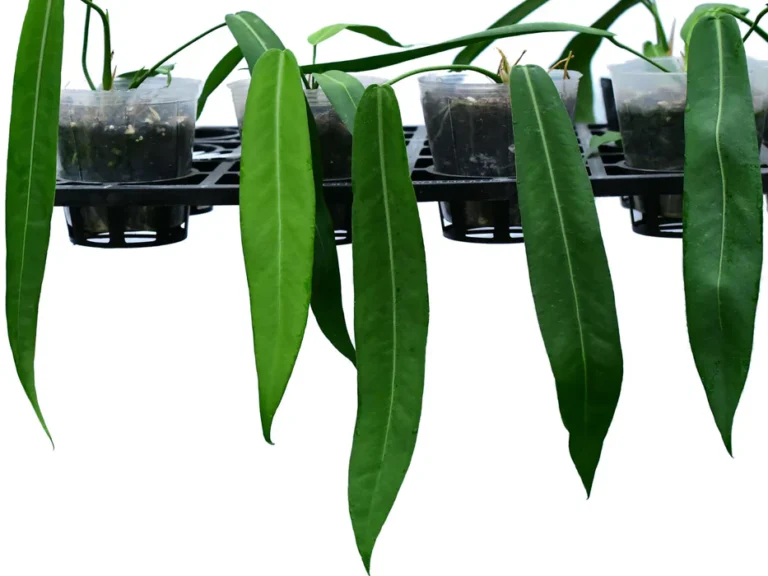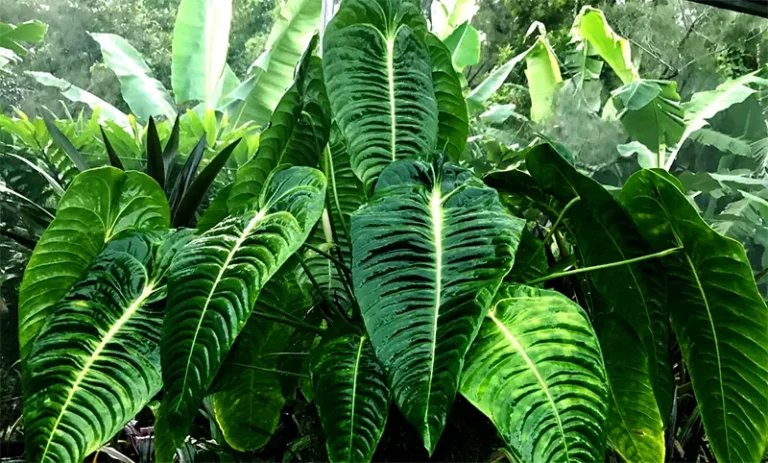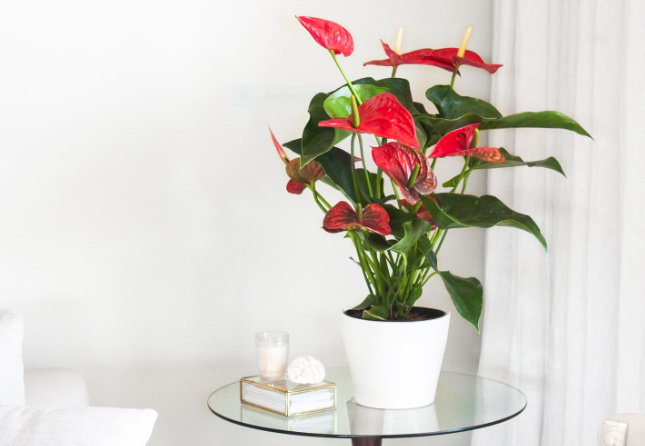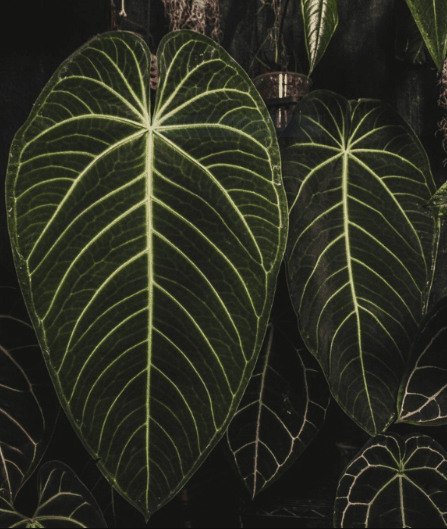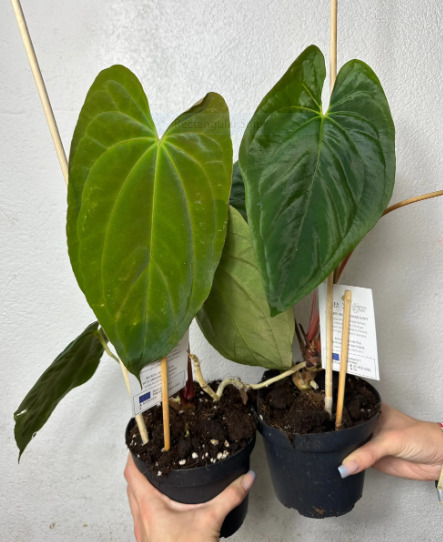ANTHURIUM CLARINERVIUM: Origin, Hybrids, Care, and Propagation
Meet Anthurium clarinervium, a tropical beauty with pretty dark green, heart-shaped, and velvety-textured leaves with prominent white veining. The plant is also known as Velvet Cupboard Anthurium, Velvet Leaf Anthurium, or Velvet Anthurium. Its decorative foliage and colorful leaf bracts make it the perfect choice for home gardeners.
In this blog post, we will briefly discuss Anthurium clarinervium, its origin, appearance, types, care, and propagation methods to help you grow it indoors!
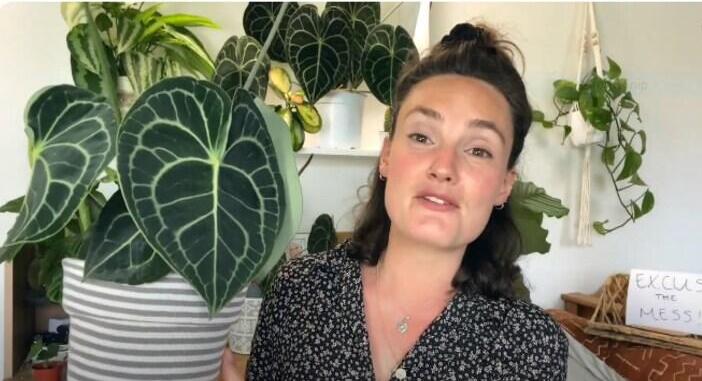
What is ANTHURIUM CLARINERVIUM?
Anthurium clarinervium is a terrestrial plant in the Flamingo flower genus. The plant belongs to the Arum (Araceae) family and grows as an epiphyte on the stems of other trees and plants.
Anthurium clarinervium can grow up to 3 feet tall, and its leaves reach 6 inches long in their natural habitat. Excess humidity and reasonable air movement keep the plant hydrated without making it soggy.
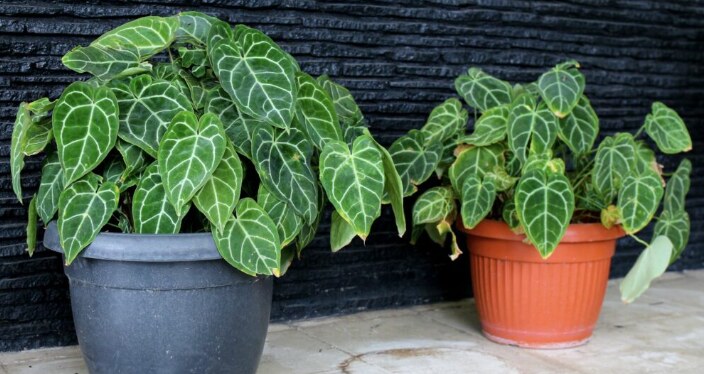
Origin:
Anthurium Clarinervium originates from southern Mexico. It grows in Chiapas’s humid forest. This epiphytic plant flourishes on limestone outcrops from 800 to 1200 meters above sea level.
Morphological Characteristics of Anthurium Clarinervium
1. Growth Pattern
This leafy plant does not grow below 30 inches (40-65cm) in height and width. Anthurium clarinervium is a slow-growing plant, so it takes almost 5-8 years to reach its mature size. During its early years, this plant was perfect for indoor cultivation. You can place it on a dining or coffee table as decor.
2. Lifespan
Compared to other leafy indoor plants, this indoor plant is long-lasting. With proper care, it can survive up to 10 years.
3. Flowers
Anthurium clarinervium produces spadix flowers like other family members of anthurium, accompanied by spathes of the same color during its growing season.
4. Leaf Color
Anthurium clarinervium has unique dark green leaves with a velvety texture. These leaves are heart-shaped and have silvery white veins.
5. Leaf Size
These leaves can grow up to 6-10 inches in length.
6. Toxicity
This leafy indoor plant is toxic and can harm your children and pets.
Anthurium Clarinervium Hybrids: Anthurium Pterodactyl, Anthurium Delta Force, King Clarinvervium, Queen Clarinervium
1. Anthurium Pterodactyl
Anthurium Pterodactyl is produced when you cross Anthurium Clarinervium with Anthurium Peatoradiatum. It is also known as Anthurum Macrolobium. This species grows in the same environment as its parents and produces a velvety texture.

2. Anthurium Delta Force
Anthurium Delta Force is a selective clone that is produced when Anthurium Clarinervium and Anthurium Pedatoradiantum Hybrid are crossed with each other. It was selected among all other seedlings for its distinctive characteristics. This hybrid produces a triangle or delta-shaped leaf blade with a sharp apex. The plant looks slightly wavy, and you can reproduce it only with a stem cutting.
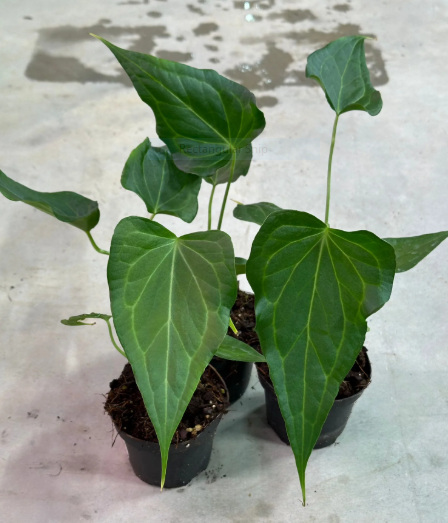
3. Anthurium King Clarinervium
Anthurium King Clarinervium is a result of a mutation in the regular Anthurium Clarinervium seedlings. This variety produces elongated leaf shape, larger leaf blades, and slightly different veining structure.
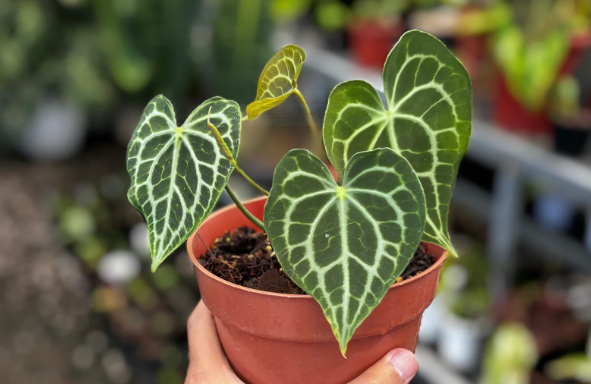
4. Anthurium Queen Clarinervium
Anthurium Queen Clarinervium, an unknown hybrid of Anthurium Clarinervium, is a beautiful plant that has a compact look. The hybrid has a receptive inflorescence.
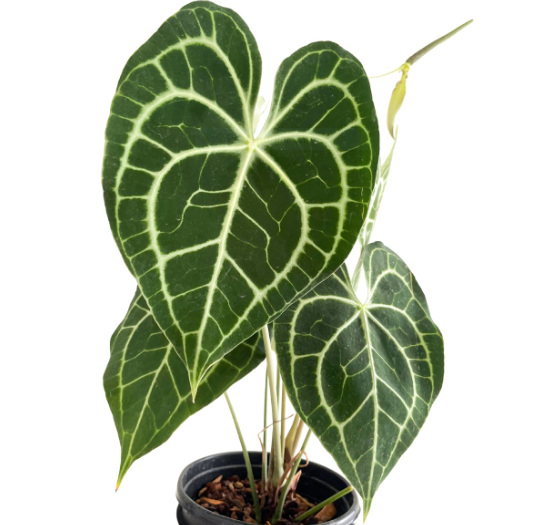
How to Grow and Care For Your Anthurium Clarinervium? A Detailed Guide
Here is how you can grow and care for your Velvet Cupboard Anthurium:
1. What are the light requirements for Anthurium Clarinervium?
Anthurium clarinervium shows pretty growth under bright and direct sunlight. During winter, when days are shorter, these plants can bear little direct sunlight. On the other hand, during summer, days are longer, so direct light hurts its growth. Providing shade is the best solution to caring for your plant.
2. Which potting soil is best for Anthurium Clarinervium?
Your plant’s main requirement for perfect indoor growth is the potting mix. Anthurium clarinervium prefers a well-drained potting medium, allowing excess oxygen to flow around the roots.
3. What temperature does Anthurium Clarinervium need?
Anthurium clarinervium loves warm temperatures to thrive. The ideal temperature for this leafy plant is 18 to 28 degrees (65F-82F); temperatures lower than 12 degrees (54F) are not ideal for its optimum growth.
This plant is susceptible to direct sunlight and high temperatures; your leafy plant cannot survive under these conditions. Do not place your plant near heaters or AC because sudden temperature fluctuations harm this trendy plant.
4. How often should you water Anthurium Clarinervium?
Anthurium clarinervium, an epiphyte plant, loves to grow when watered frequently, but avoid overwatering as it can cause the soil to become soggy. Before watering your Anthurium clarinervium;
The best time to water your anthurium clarinervium is in the morning. This gives the plants excess time to use the required amount of water.
Overwatering can cause root rot, yellowing leaves, and mushy stems, while underwatering can cause dry leaves. So, avoid both these conditions to keep your plant healthy.
5. What humidity does Anthurium Clarinervium require?
Anthurium clarinervium requires enough humidity to thrive. The humidity between 40 percent to 60 percent is ideal for its proper growth.
If cared for, this species of anthurium can grow well in the greenhouse and indoors. If your plant faces dry air, such as in the winter, use a humidifier to increase humidity. This is highly recommended for your large-leaf plant.
Too much high humidity can harm its growth because if the leaves of your velvety leafy plant remain moist for a long time, it can cause fungal growth.
6. How often should you fertilize your Anthurium Clarinervium?
Fertilize your anthurium clarinervium once a month during its growing seasons, summer and spring.
Change the soil of your houseplant every three months to protect it from salt and mineral buildup from fertilizers.
7. When to repot your Anthurium Clarinervium?
The spring season is the best time to repot your plant because it is the start of the anthurium growing season.
If your plant is new, repotting should be done once a year, but if it is old, you can repot it after two to three years.
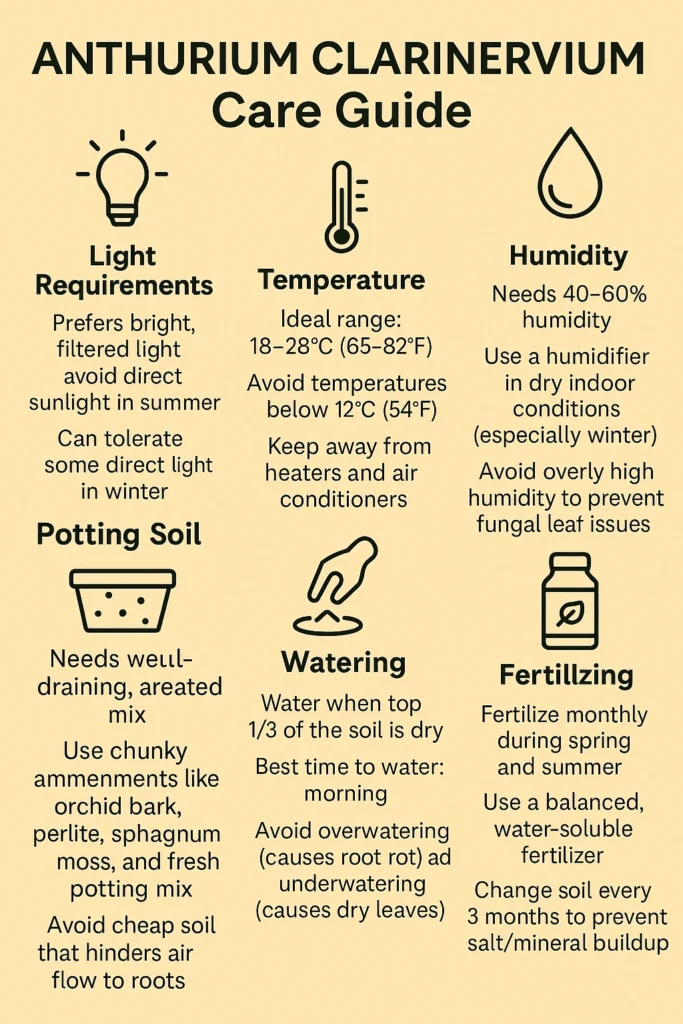
ANTHURIUM CLARINERVIUM PROPAGATION GUIDE
Here are some methods to consider when propagating your anthurium clarinervium.
1. Seed propagation of Anthurium Clarinervium
Propagation through seed pollination is a highly satisfying method for anthurium clarinervium. However, it takes time to develop barriers. These barriers require 8-12 months to mature and ripen. When they are fully developed, they become round and orange. Place a seed from each berry on moist sphagnum moss to grow new seedlings.
2. Stem cutting propagation of Anthurium Clarinervium
If you don’t like the pollination process, you can do stem-cutting propagation to get a new plant. The cutting method of propagation is faster than seed propagation. Trim the stem beneath the node, then plant the upper portion in moss. After that, the lower part of the stem starts producing new shoots. In a short time, you will have two new, fresh plants.
Anthurium Clarinervium Common Problems
1. Root Rot
Overwatering and improper drainage are the leading causes of root rot. To prevent root rot in your leafy plant, keep it well-drained and water only when the soil feels dry. Anthurium clarinervium prefers moist soil to flourish.
Yellowing leaves and mushy brown roots indicate your plant is facing root rot. Preventing this problem from happening to your houseplant is easy.
Your anthurium clarinervium will be very grateful for the care!
2. Bacterial and Fungal Infections
Softening or blackening of roots or stems are signs of bacterial infection, while spots on the leaves or stems are signs of fungal infection. Your velvet cardboard anthurium will face these problems because of overwatering, improper potting mix, and bad air circulation.
If you notice these infections,
3. Pest Attack
Spider mites and mealybugs are the predominant pests on your anthurium. Mealybugs are cotton-like pests that get nutrients from the leaves. If this problem is not treated correctly, it can cause the death of a plant. You can quickly solve this issue using a cotton swab with isopropyl alcohol.
4. Brown scales
They are also known as common pests that infest your leafy plant. Its appearance is just like a mosquito. These pests extract sap from the plant body using their piercing mouthparts and cause the plant to die or lose its vibrant dark green color.
Neem Oil is the best natural remedy for controlling brown scale. Dilute it as mentioned in the product instructions and apply it to the affected area of a plant with a soft cloth and spray bottle.
5. Small leaves
If you notice dull veining or leggy stems with small leaves, your plant needs to receive more light. So, change the place where your plant is. Keep it under bright and indirect light for better growth.
Also Check Anthurium Warocqueanum?
FAQs
1. Can anthurium clarinervium survive without natural light?
It can survive under low light conditions, but these leafy plants do not produce flowers without natural light or sunlight.
2. Is anthurium clarinervium poisonous?
This anthurium species is slightly poisonous. Wear gloves for care when you start repotting and propagating your plant.
Conclusion
Anthurium Clarinervium, also knows as the Velvet Cupboard Anthurium, hails from sotuhern Mexico and is easy to care for. With its beautiful foliage, this variety can be a great addition to your home garden. The plant requires indirect light, enough humidity, adequate water, and warm temperatures when grown indoors. Follow these steps of care and enjoy the beauty of this unique plant.

About Author
Hi, I’m Emily Davis, a passionate tropical plant enthusiast dedicated to sharing knowledge and expertise with plant lovers. Through his blog, I will provide guides, tips, and tricks for caring for tropical houseplants species like Alocasia, Anthurium, Calathea, Philodendron, Begonia, and many more that will help readers bring a touch of paradise into their own homes. With a deep love for the vibrant colors and lush textures of tropical flora, I’m committed to inspiring others to cultivate their own tropical oasis.

